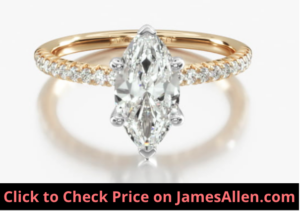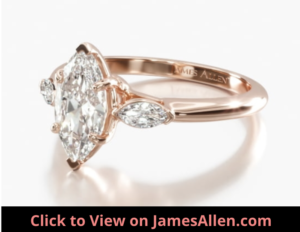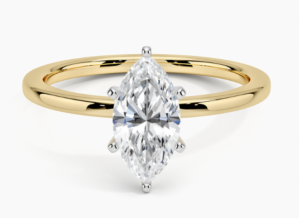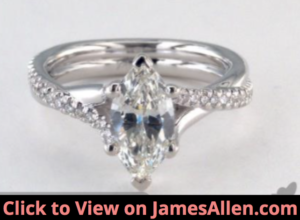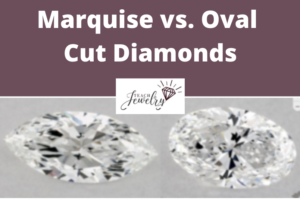
Marquise and oval cuts can serve as the center diamond on an engagement ring or complement the main gem as accents.
The main difference between marquise and oval cut diamonds is marquise cuts have pointed ends on either side. Oval cuts have smooth edges all the way around and never come to a sharp point. Both have brilliant cut facets that result in strong white light radiating from its surface.
We’ll compare marquise versus oval cut diamonds across the traits that most affect a diamond’s quality and appearance, including five differences, so you’ll know if either is right for you.
What is a Marquise Cut?
The distinguishing feature of a marquise cut diamond is its elongated shape that’s wide in the middle and extends to two sharp points on each side.
It often has 58 total facets, with 33 on its crown and 25 on the pavilion.
Check out the engagement ring below with a marquise cut.
Notice how it’s placed vertically on the ring and stands much taller than a round cut. In almost every case, it’s set this direction, but you can find horizontal variations.
Marquise diamonds are modified brilliant cuts, which means the shape of its facets are comparable to a round cut.
The triangle and kite-shaped facets enhance its brilliance, so one of the pros of marquise cuts is it has a unique shape that doesn’t sacrifice too much brilliance.
The ideal length to width ratio is 1.75-2.15, but they come in a variety of ratios.
For example, here’s a marquise cut from where I bought my wife’s engagement ring.
It’s more condensed with a shorter length to width ratio.
The cut is also called a “Navette”, which means “small ship” in French. It’s referred to as an eye- or boat-shaped diamond.
What are Oval Cut Diamonds?
Oval cut diamonds are a modern cut with rounded edges. Its design combines the techniques used to create and round and pear cuts.
As a modified brilliant cut, its facets return a significant amount of white light.
Check out this stunning image of an oval cut diamond surrounded by pavé.
Similar to the marquise cut, it’s set vertically on the shank between four prongs, but there are also horizontal variations.
There are a variety of shapes to explore.
Some are stretched and more shallow, while others are condensed with a deep table.
The ideal length to width ratio is 1.35-1.50.
Oval cuts were designed in the mid-1900s by Russian diamond cutter Lazare Kaplan.
What are Differences?
1. Size
The size of a diamond isn’t measured by visible appearance. It’s measured in carats, which is a unit of weight equal to 0.2 grams.
If you place two diamonds next to each other, and they both weigh 0.75 carats, they’re the same size, even if one looks bigger than the other.
Certain cuts look larger than others, even if they’re the same weight.
Marquise diamonds are known to look larger than oval cuts and all other cuts. Its stretched shape gives it a wide surface area.
Here’s a marquise and oval cut placed side-by-side.
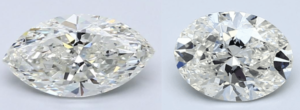
From end to end, the marquise cut’s length is longer than oval cuts, which gives the illusion it’s a larger diamond.
If you’re interested in maximizing the apparent size of your diamond, consider a marquise cut.
You’ll have a diamond that looks the same size as another cut of a higher carat without paying the premium.
2. Popularity in Engagement Rings
Some buyers are drawn to round brilliant cuts because they want the most popular type of diamond for their engagement ring.
Others seek to avoid the traditional route and choose a fancy shape.
It’s estimated marquise diamonds are the third most popular cut behind round and princess, making up five percent of diamonds sold.
The high ranking is no surprise, given its ability to display a sense of elegance in a solitaire setting or surrounded by accents, like the one below.
Oval cuts rank sixth, capturing less than three percent of the diamond market. But in my analysis of 250 celebrity engagement rings, they accounted for 18 percent.
As a contrast, my research indicated less than five percent of celebrities are sporting a marquise cut.
But the market share of each is reflected in the number of options you’ll have to choose from at most diamond retailers.
You’ll often have far more choices of round cut compared to marquise and oval cuts.
3. Prices
Marquise cuts often sell for a higher price compared to oval cuts.
For example, Blue Nile used its own inventory to compare diamond prices by their shape.
It found marquise diamonds sell for 23 percent higher than oval cuts with the same characteristics.
I compiled prices for marquise and oval cut diamonds from James Allen with the following traits:
- Carat: 1.00
- Color: F
- Clarity: SI1
The average price for a marquise cut with those qualities is $4,636. The lowest priced marquise cut is $4,030, and the highest is $5,140.
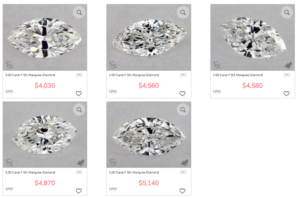
For an oval cut, the average is $4,224, with a range of $3,550-$4,960.
So there’s a 10 percent premium for a marquise cut versus an oval cut diamond.
Both fancy shapes are less expensive than a round cut.
If you’re looking to maximize the carat weight of your diamond or want to improve its clarity, cut, color, or setting within a set budget, consider a marquise or oval cut instead of a round cut.
4. Settings
The setting that holds your diamond adds an entirely new element to the ring and presents you with some choices.
Marquise cuts require a setting to hold each end.
Notice how in the example below, the prongs are uniform on the sharp ends and the rounded edges.
There are other instances where a V-prong holds the ends, and traditional prongs grip the rounded edges in a similar way they would a round cut.
The setting below illustrates that style.
It’s a subtle difference, and the minimalist design allows the most light to enter and exit the diamond through its exposed table.
Marquise diamonds can also be surrounded by a single or double halo.
By placing accents around the center diamond, you add sparkle to the piece and create the illusion of a larger diamond without the corresponding price increase.
Oval cuts are often held in place by four or six prongs.
Bezel settings also complement oval cuts because they mimic the shape of the diamond and secure it from hits and drops.
The downside is it hides more of the diamond than prongs.
No matter how the setting holds a marquise or oval cut, you can also add diamonds to any type of ring shank.
Whether it’s channel-set or bead-set diamonds, add glimmer to the ring without increasing the size of the main diamond.
To illustrate, here’s an oval cut with a channel setting.
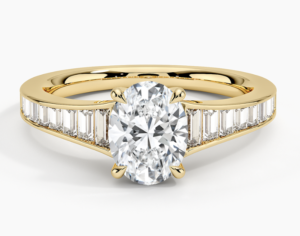
Notice how there are small diamonds set within the grooves, and a lip stretches over to hold them in place.
If you want all the attention on the center diamond, choose a solitaire setting. Both produce enough light return to stand alone.
5. Vulnerability to Chipping
One pro of oval cuts is they’re more durable than marquise cuts.
The rounded edges of an oval are less vulnerable to chipping. Pointed ends are a weak point in any diamond, and marquise cuts have them on both sides.
If a marquise cut is unprotected and is hit against a hard surface, its ends may break.
The remedy for this problem is to protect them with a strong setting.
V-prongs at each end, like on the setting below, provide some degree of protection but not as much as a bezel setting.
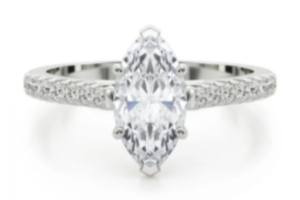
The best ways to prevent issues related to durability for marquise and oval cuts are to remove them during physical activity and choose a setting that prioritizes security over maximizing light performance and visibility.
Also avoid significant inclusions in vulnerable areas.
What do They Have in Common?
Marquise and oval cuts are susceptible to the bow-tie effect. Black lines span a diamond’s table and form the shape of a bow-tie.
Almost all marquise and oval cuts have some degree of this problem, but its visibility differs depending on the quality of the cut.
Here’s an image of what it looks like in each cut.
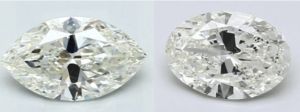
Notice how it crosses almost straight through the middle.
In some instances, the bow-tie is apparent no matter which angle you view the diamond. In others, it’s nearly invisible.
You can’t tell whether a diamond has the bow-tie effect from its grading report. Even one with ideal proportions, depth, and clarity can have this issue.
By viewing the diamond in-person or through a high-quality photo online, you can avoid a marquise or oval cut with this flaw.
Is a Marquise or Oval Cut the Right Choice For You?
If you’re comparing marquise versus oval cut diamonds, knowing what to expect in terms of their size, durability, clarity, and color is one of the first steps.
Here are some guidelines to help you decide which is right for you.
Choose a marquise cut if:
- The elongated shape with pointed ends is appealing
- You’re willing to pay a higher price per carat than other fancy shapes
- Strong brilliance is a priority, but you want an alternative to a round cut
- Your setting will protect its pointed ends from chipping
Consider an oval cut if:
- You don’t want a round brilliant cut but still prefer rounded edges over sharp corners
- Its lower cost per carat allows you to choose improved grades in other areas
- It’s important to you that the diamond is durable and isn’t vulnerable to chipping, even if you don’t choose a setting that maximizes protection
- You’re interested in a close alternative to a round cut
Marquise and oval cuts can serve as the center diamond in any engagement ring or piece of jewelry.
By learning the characteristics of both, you’ll find the perfect ring for you.

Jacob Clarke
Jacob Clarke is the founder of TeachJewelry.com.
He earned an Applied Jewelry Professional Diploma from the Gemological Institute of America (GIA) and now brings you essential information about diamonds, settings, and more.
Jacob has consulted with leading jewelry brands, and his work has been cited in Clean Origin, Diamond Nexus and industry publications.
He's also a member of the International Gem Society.
He enjoys discussing jewelry with readers, so contact him with any questions at jacob.clarke@teachjewelry.com.

